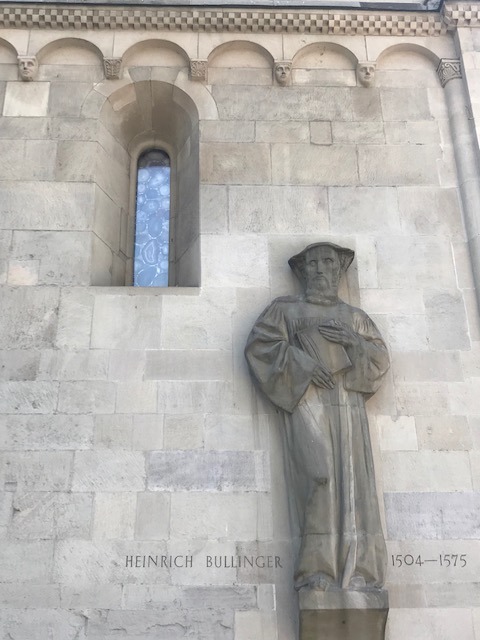Reformed Network in Europe

On the Edition of the Correspondence of Heinrich Bullinger (1504–1575)
Among the great figures of the Reformation, Luther, Zwingli and Calvin undoubtedly stand out. Heinrich Bullinger, however, the son of a priest from Bremgarten, who took over the helm of the Zurich church as a young man after the early death of Zwingli and made Zurich one of the centers of Protestant Europe, stood for too long in the shadow of his pioneering predecessor as well as his brother in Geneva, whose name was even transferred to the Reformed branch of Protestantism. Although Bullinger is often referred to as the father of Reformed Protestantism, his writings, which were widely read and often translated until the 17th century, have largely been forgotten, apart from the Second Helvetic Confession (1566), which still serves as a doctrinal basis for some churches today. Of course, it is not as if the decades of restless work of the Zurich antist did not have a lasting impact. Bullinger not only consolidated the Zurich church system after the catastrophe of Kappel (1531), but also advised, promoted and helped shape the Reformed communities far beyond the borders of Switzerland. As a theologian, he deepened the independent profile of the Zwinglian Reformation, while at the same time striving to reach an understanding with representatives of dissenting doctrines. The extent to which Bullinger’s theological thinking still lives on today is shown, for example, by the historical connection between his theology of the covenant (federal theology) and the political theology of federalism.
For some time now, historians and theologians in Zurich and elsewhere have been working on the scholarly cataloging of Bullinger's written legacy. It has always been known that the reformer’s extremely extensive correspondence is of particular importance. With the collections compiled partly by Bullinger himself, but then above all by Johann Jakob Breitinger, Johann Heinrich Hottinger and Johann Jakob Simler in the 17th and 18th centuries, Zurich is home to a treasure trove of sources on the history of the Reformation that is probably unique in the world. Scholars have repeatedly and painstakingly endeavored to raise it (cf. chronology of the Bullinger correspondence edition), but the extraordinary wealth has not allowed them to go beyond the publication of individual groups of letters (e.g. Bullinger’s correspondence with the Grisons).
No fewer than 10,000 letters addressed to Bullinger and 2,000 letters written by him are now recorded in the index of the edition of the correspondence; this is probably the most extensive correspondence of the 16th century (cf. data on the letter edition). It stretches from Scotland to Belarus and from Denmark to Italy. More than 1,100 correspondents were involved in this network of letters. This extends from Scotland to Belarus and from Denmark to Italy. More than 1,100 correspondents were involved in this network of letters. It is particularly interesting to note that the participants came from all walks of life: From scholars and statesmen to craftsmen who barely knew how to write. Around four-fifths of the letters were written in Latin, one-fifth in early New High German and a few letters in French, Italian or Greek.
Bullinger’s correspondence contains information of a political, biographical, economic and climatological nature, as well as information on the history of mentality and culture. It contains a particularly large amount of often unknown information about the prints of the time, which can be particularly revealing in the case of a print published anonymously or under a pseudonym. With its indexing of previously inaccessible manuscript sources, the edition makes a decisive contribution to the reorientation of historiography and is to be recognized in a further, international indexing process of correspondence networks. It is also of great interest for linguistics, namely for studies on the development of late Latin and early New High German, but unfortunately its importance has hardly been recognized.
Because of the quantity and variety of information conveyed in it, because of its density (on average two letters every third day - so that critical comparisons are often possible for a given event because there are several reports or reactions), because of its time span of over fifty years (1524–1575), its geographical breadth and in view of the growing interest in epistolography and networks in general and the early modern period in particular (especially as letters allow a more intimate insight into the past than printed books, for example), Bullinger’s correspondence is an indispensable source for recording the history and culture of Europe in the 16th century. century.
It is thanks to the joint efforts of the Institute for Swiss Reformation Studies, the Zwingliverein and the Theologischer Verlag Zurich, and in particular the funding provided by the Swiss National Science Foundation and the Reformed Church of the Canton of Zurich, that this chronological edition of letters can be published at all.
So far, 2,896 letters from the years 1524 to March 1547 have been published in the 20 published volumes (including an additional volume 10A). Since volume 7, those letters that have already been published in sufficient quality in easily accessible publications from the 19th to 21st centuries have only been reproduced in German in a detailed summary. Measured against the volumes published to date, this corresponds to approx. 15% of the entire correspondence. Up to volume 14, all letters were provided with a German regest, but from volume 15 onwards with a more detailed German summary. Volume 20 is currently being edited.
Since November 2013, the printed volumes, with the exception of those published less than two years ago, have been made freely accessible to the public online by means of an electronic edition (see Electronic Edition). This makes combined studies of these letters possible for the first time.
